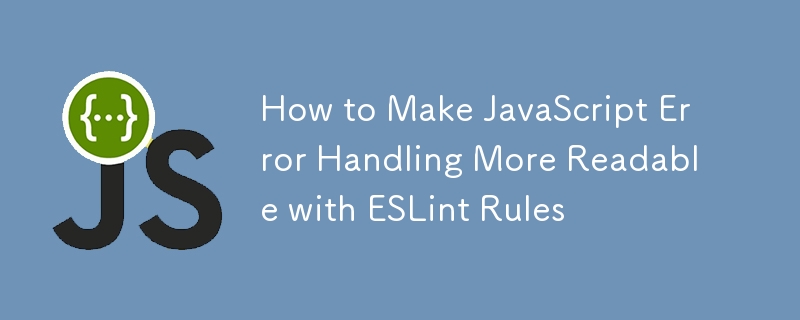如何使用 ESLint 规则使 JavaScript 错误处理更具可读性
- DDD原创
- 2024-10-09 06:20:29504浏览

简介:掌握 JavaScript 中的错误处理
有效的错误处理对于任何健壮的 JavaScript 应用程序都至关重要。它有助于快速识别问题、简化调试并增强软件可靠性。本指南深入探讨通过 ESLint 改进 JavaScript 错误处理,ESLint 是一种增强代码质量并标准化错误处理实践的工具。
为什么要关注可读的错误处理?
可读的错误处理提供了对问题的即时洞察,帮助开发人员有效地理解和解决问题。这种做法在团队环境中至关重要,对于长期维护代码也至关重要。
实施更好的错误处理实践
要增强 JavaScript 错误处理能力,请考虑以下策略:
1. 有效使用 Try-Catch 块
try {
const data = JSON.parse(response);
console.log(data);
} catch (error) {
console.error("Failed to parse response:", error);
}
2. 开发自定义错误类
class ValidationError extends Error {
constructor(message) {
super(message);
this.name = "ValidationError";
}
}
try {
throw new ValidationError("Invalid email address");
} catch (error) {
console.error(error.name, error.message);
}
3. 确保详细的错误记录
function handleError(error) {
console.error(`${new Date().toISOString()} - Error: ${error.message}`);
}
4. 区分投掷和非投掷函数
投掷版本:
function calculateAge(dob) {
if (!dob) throw new Error("Date of birth is required");
}
非投掷版本:
function tryCalculateAge(dob) {
if (!dob) {
console.error("Date of birth is required");
return null;
}
}
使用 ESLint 强制执行错误处理
设置 ESLint 来强制执行这些实践涉及以下步骤和配置:
1. 安装并设置 ESLint
npm install eslint --save-dev npx eslint --init
2. 配置 ESLint 错误处理规则
有效的错误处理对于开发健壮的 JavaScript 应用程序至关重要。以下是 ESLint 规则,可以帮助您在代码库中实施良好的错误处理实践。
1. No Unhandled Promises
- Rule:
"promise/no-return-in-finally": "warn", "promise/always-return": "error"
- Explanation: This configuration ensures that promises always handle errors and don’t unintentionally suppress returned values in finally blocks.
2. No Await Inside a Loop
- Rule:
"no-await-in-loop": "error"
- Explanation: Awaits inside loops can lead to performance issues, as each iteration waits for a promise to resolve sequentially. It's better to use Promise.all() for handling multiple promises.
- Example:
// Incorrect
async function processArray(array) {
for (let item of array) {
await processItem(item);
}
}
// Correct
async function processArray(array) {
const promises = array.map(item => processItem(item));
await Promise.all(promises);
}
3. Proper Error Handling in Async Functions
- Rule:
"promise/catch-or-return": "error", "async-await/space-after-async": "error"
- Explanation: Enforce that all asynchronous functions handle errors either by catching them or by returning the promise chain.
4. Consistent Return in Functions
- Rule:
"consistent-return": "error"
- Explanation: This rule enforces a consistent handling of return statements in functions, making it clear whether functions are expected to return a value or not, which is crucial for error handling and debugging.
5. Disallowing Unused Catch Bindings
- Rule:
"no-unused-vars": ["error", {"args": "none"}],
"no-unused-catch-bindings": "error"
- Explanation: Ensures that variables declared in catch blocks are used. This prevents ignoring error details and encourages proper error handling.
6. Enforce Throwing of Error Objects
- Rule:
"no-throw-literal": "error"
- Explanation: This rule ensures that only Error objects are thrown. Throwing literals or non-error objects often leads to less informative error messages and harder debugging.
- Example:
// Incorrect
throw 'error';
// Correct
throw new Error('An error occurred');
7. Limiting Maximum Depth of Callbacks
- Rule:
"max-nested-callbacks": ["warn", 3]
- Explanation: Deeply nested callbacks can make code less readable and error-prone. Limiting the nesting of callbacks encourages simpler, more maintainable code structures.
8. Avoiding Unused Expressions in Error Handling
- Rule:
"no-unused-expressions": ["error", {"allowShortCircuit": true, "allowTernary": true}]
- Explanation: This rule aims to eliminate unused expressions which do not affect the state of the program and can lead to errors being silently ignored.
9. Require Error Handling in Callbacks
- Rule:
"node/handle-callback-err": "error"
- Explanation: Enforces handling error parameters in callbacks, a common pattern in Node.js and other asynchronous JavaScript code.
10. Disallowing the Use of Console
- Rule:
"no-console": "warn"
- Explanation: While not strictly an error handling rule, discouraging the use of console helps in avoiding leaking potentially sensitive error details in production environments and encourages the use of more sophisticated logging mechanisms.
3. Integrate ESLint into Your Development Workflow
Ensure ESLint runs automatically before code commits or during CI/CD processes.
Conclusion: Enhancing Code Quality with ESLint
By adopting these ESLint rules and error-handling strategies, you elevate the readability and reliability of your JavaScript applications. These improvements facilitate debugging and ensure a smoother user experience.
Final Thought
Are you ready to transform your error handling approach? Implement these practices in your projects to see a significant boost in your development efficiency and code quality. Embrace these enhancements and lead your projects to success.
以上是如何使用 ESLint 规则使 JavaScript 错误处理更具可读性的详细内容。更多信息请关注PHP中文网其他相关文章!

